The 7 Leave No Trace Principles & How to Follow Them
Not sure where to pitch your tent, how to do dishes, or where to go the dreaded #2? Brush up on your outdoor ethics here.

As more people get outside, it’s critical that we as outdoor enthusiasts know how to enjoy the outdoors responsibly and with as little impact as possible so the special places we recreate in remain that way for us to continue to enjoy and for future generations as well. That’s where the 7 basic principles of Leave No Trace come in.
Before we get into what the principles of Leave No Trace are and how we can use them to minimize our impact when we’re playing outside, let’s cover what Leave No Trace is not.
- Leave No Trace is not about rules and regulations
- Leave No Trace is not about right vs. wrong
- Leave No Trace is not black and white
With that said, Leave No Trace is even more than a set of guidelines. It is an ethic, a belief, a state of mind, and a way of existing in the world where we respect our surroundings (and others) and are making positive decisions that create an environment we wish to live in.
In this post, we cover the 7 principles of Leave No Trace and how to follow them so we can all do our part to keep the places we recreate beautiful.
This post may contain affiliate links.
What is Leave No Trace?
Leave No Trace is a non-profit organization that has established an easy to understand framework of ethics and best practices for minimum impact when we are on the trail, camping, and recreating outside. The purpose is to build a foundation of respect for our wild places so we can conserve the integrity of the land that we love getting out and experiencing.
The 7 principles of Leave No Trace are a framework for making responsible decisions when we spend time outdoors so that we can continue to have wild and healthy places to explore for generations to come.
It’s not about placing rules on what we can and cannot do in the outdoors; instead Leave No Trace is what allows us to have fewer rules. If we all take care of the places that we play, then there is no need for rules; but once we begin to leave our trash, go off trails, and do our dirty business anywhere we want – that’s when we begin to see areas degraded, closed to use, and rules enforced.
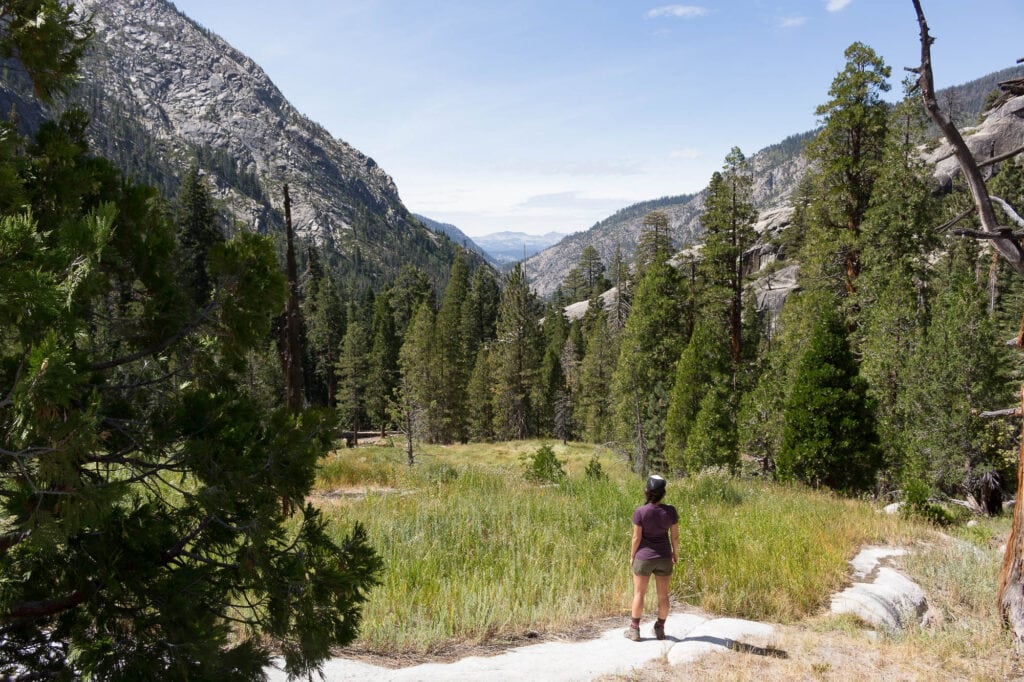
Save this post!
Enter your email & I'll send this post to your inbox! You'll also receive my weekly newsletter full of helpful advice for planning your adventures.
The 7 Principles of Leave No Trace
There are 7 Principles of Leave No Trace and they are all pretty much common sense. The principles and techniques for minimizing impact vary depending on the activity you’re partaking in, the environment you’re in, and how many people are in your group.
We’ll cover the 7 Principles on a very basic level, and if you are interested in more specific techniques or the science behind the guidelines, visit the Leave No Trace website or take a Trainer or Master Educator Course to get certified and enhance your knowledge!
1) Plan Ahead and Prepare
The first principle of Leave No Trace is to plan ahead and prepare. This will not only make your trip more enjoyable, comfortable, and safe but will also help prevent damage to natural resources.
Here are some tips to help you plan ahead and prepare for your adventures:
- Do your research ahead of time; depending on your trip this can take 30 minutes or many months.
- Know the regulations. For example, are fires allowed, is a permit required, what wildlife lives in the area, is bearproof food storage needed, etc?
- Check the forecast so you can pack and prepare for appropriate weather. Be prepared for extreme weather and the unexpected.
- Be aware of hazards like flash floods in the desert, and have an emergency plan – know what you are going to do if someone gets hurt or lost.
- Schedule your trip during non-peak times. No one likes waiting in a line to be outside.
- Repackage your food to minimize potential waste when you’re out there. Leave the cardboard box that your oatmeal packets are in at home.
- Double check that you have everything you need to have a fun and safe time. It’s always a good idea to let someone know where you’re going, when you plan on coming back, and what to do if you don’t.
2) Travel & Camp on Durable Surfaces
The general rule here is if a trail or campsite exists – stick to it. If a trail or campsite does not exist – do your best not to create one. The purpose of this Leave No Trace principle is to help us avoid creating new scars on untouched areas and trampling on vegetation and communities of microorganisms such as those that live on cryptobiotic soil.
IN POPULAR AREAS:
- Concentrate use on existing trails and campsites
- Stay on the trail – no cutting switchbacks! Walk right through that mud puddle in the middle of the trail – that’s why you wore hiking boots, get dirty!
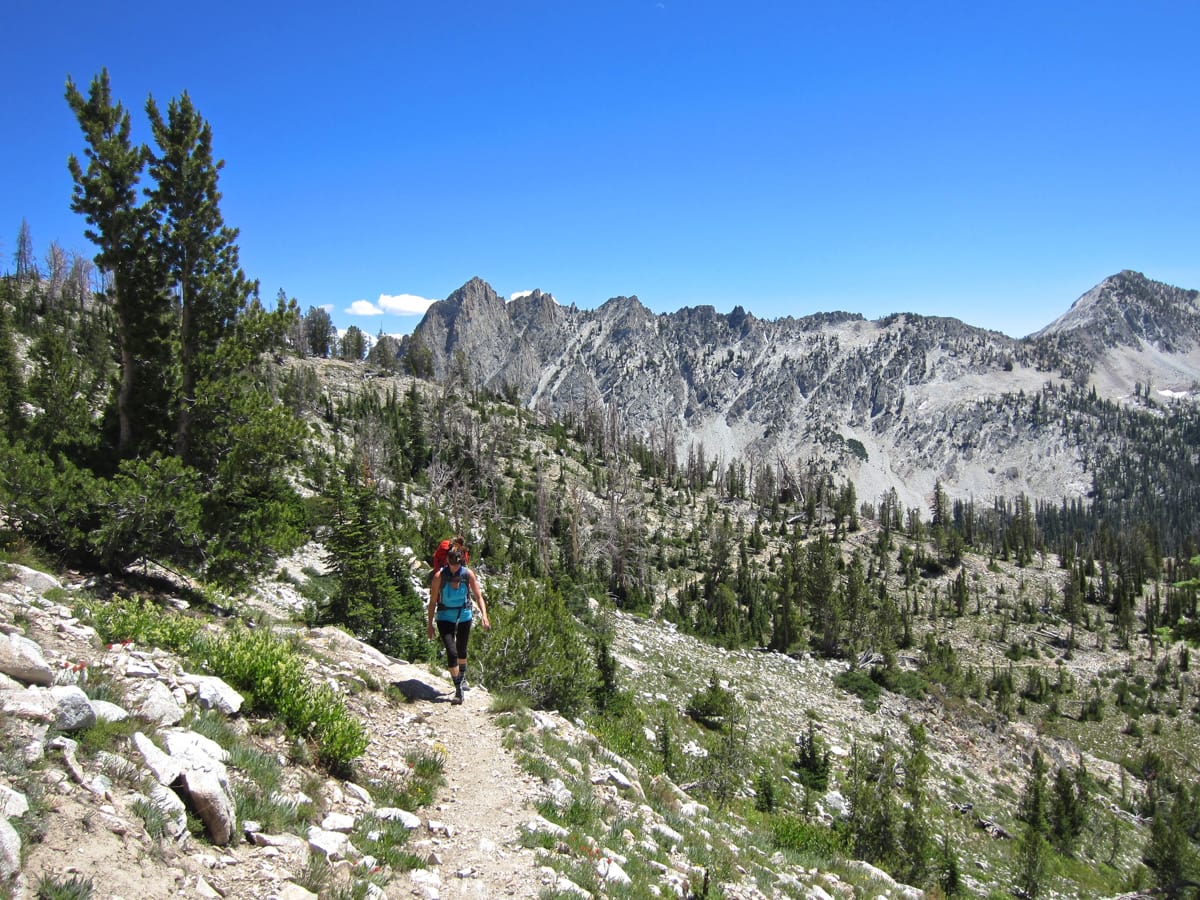
IN PRISTINE AREAS:
- Disperse use so that you are not creating trails or sites where one did not previously exist.
- Stick to durable surfaces like rock, sand, gravel, and dry grasses
- Avoid fragile surfaces like vegetation and riparian zones (that’s the area near a water source).
- Avoid places where impacts are just beginning.
- When you leave, it should look as if you were never there!
- Protect water sources by camping 70 big steps away from water.

3) Dispose of Waste Properly
We want to leave places as good or better than we found them and a big part of this is packing out all of our trash along with any that we find along the way.
Pack it in Pack it out
- This means pack out everything including food scraps, apple cores, orange peels, toilet paper, etc. Although these items biodegrade eventually, it can take a long time for this to occur and in the meantime, they can harm wildlife and detract from the beauty of a place.
Human Waste
- If there’s a bathroom USE IT. If there’s not, we shouldn’t just poop anywhere we’d like.
- If you need to poop make sure to go 70 big steps away from water, trails, and camp – then dig a hole.
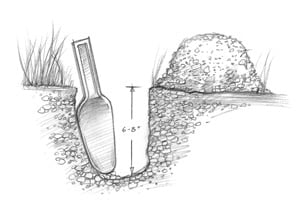
- Find a place that has nice rich soil, your cathole should be 6-8 inches deep. This allows the microbiotic activity in the soil to break down your waste.
- When finished, fill your cathole in with the dirt you took out. Pack out your toilet paper and ALL feminine products. We like to use doggy bags or a Ziploc bag covered in duct tape so you don’t have to look at your poopy TP.
- Be aware of areas with special regulations, like the Whitney Portal and many permitted rivers that require you to not only carry out the TP, but also the poo in sealable bags that make it easy to pack out and dispose of.
Check out our step by step guide on how to poop outdoors for more on this topic.
Washwater
- To wash yourself or your dishes, carry water 200 feet away from streams or lakes and use small amounts of biodegradable soap or no soap at all.
- DO NOT use soap, even eco-friendly biodegradable soap, directly in water sources.
- Scatter strained dishwater over dirt, away from water sources, and pack out the food scraps with the rest of your trash.
For more information on how to do dishes deep in the backcountry, see this post.
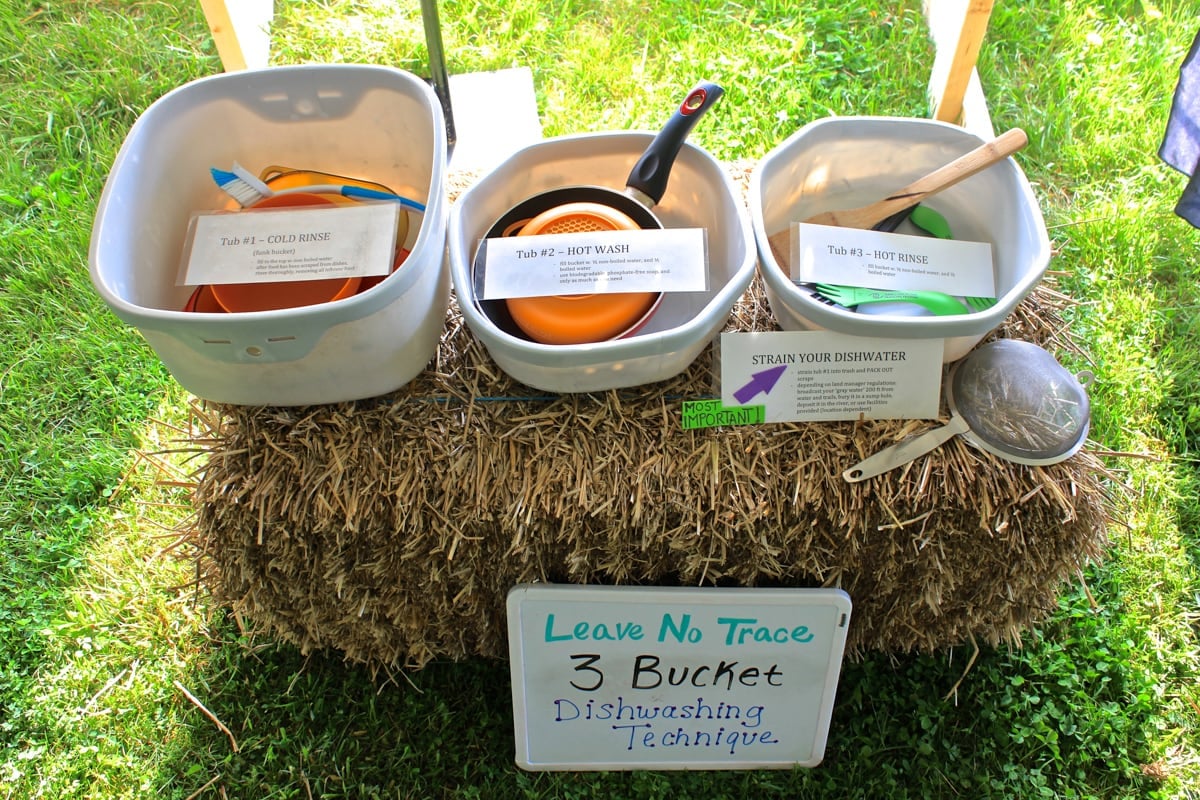
4) Leave What you Find
This one’s easy. See something cool? Take a picture, put it back. Boom! Leave what you find behind so the next person can enjoy it too. In fact, in some places it’s illegal to remove natural objects.
This Leave No Trace principle also reminds us to leave areas as we found them (or better). When setting up camp, minimize site alterations and avoid damaging plants.
Here are a couple of tips to help you minimize your impact:
- Don’t pick wildflowers. The seeds are needed for future seasons, plus if everyone picked a few flowers on every trip the collective impact would be substantial.
- Don’t collect shells, rocks, or other natural items. Rather, let them be and enjoy them where they are.
- Don’t cut branches off of trees, hack into them, or hammer nails into them to hang things.
- Don’t carve your initials into trees or draw on rocks.
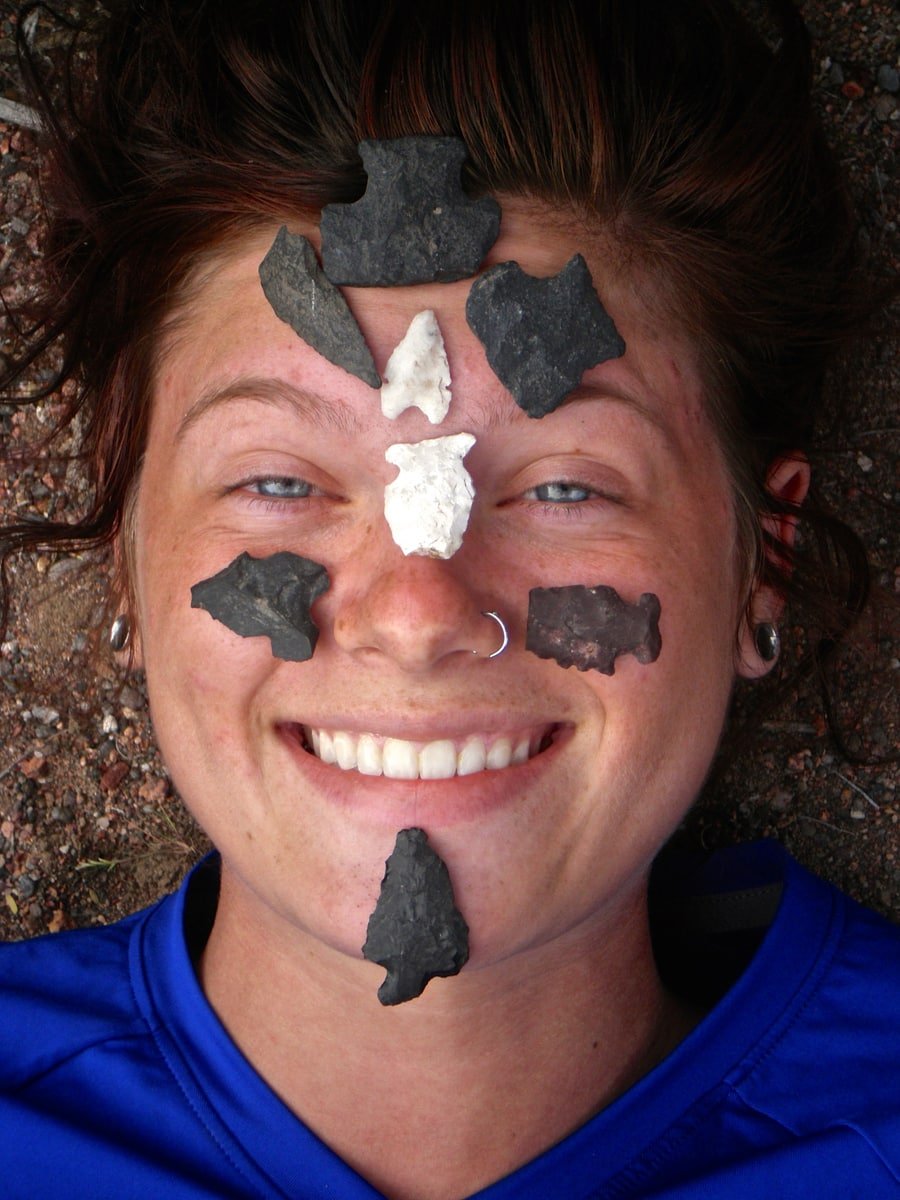
5) Minimize Campfire Impacts.
Let’s keep this one simple too. If there is a designated fire pit and no fire ban in effect, it’s time to sit around a warm fire and cozy up with your s’mores and ghost stories. If this isn’t possible, use a lightweight stove to cook your food, connect with your surroundings without firelight, and enjoy that big beautiful sky full of stars.
Here are a few tips for a campfire with minimal impact:
- Build your fire in an existing fire ring.
- Gather wood from a wide area and only use scraps from already dead and downed trees. Avoid gathering wood and having a fire where wood is sparse.
- Assess the situation and only have a fire if you feel like you have the skills to keep it under control.
- Keep your fires small, in control, and never leave them unattended.
- Put out your fire completely with water when you’re done.
- Don’t throw your trash in the fire for the next camper to find.
- Use a fire pan like this packable fire pit in places where fires are allowed but there are no existing fire rings.
ProTip. If no fires are allowed a camp light like this solar one by BioLite laid on the ground creates a surprising likeness to a fire. People will gather around. You may even see some folks with their backs turned warming up their buns!
Get more tips for having a safe campfire here.
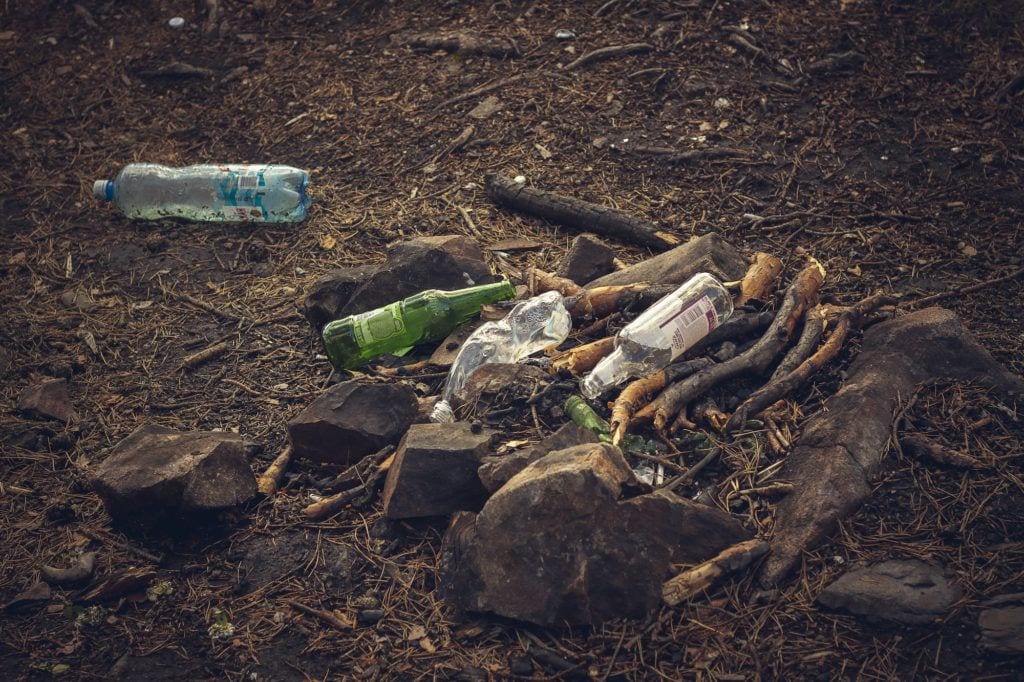
6) Respect Wildlife
You’re in their home so give ’em a break. Observe wildlife from a safe distance and don’t disturb them by trying to get closer for a pic. Let them do their thing in peace.
Here are some tips to be respectful of wildlife:
- Don’t touch wildlife. Some animals can harbor rabies or other diseases, and it’s possible that if you touch young animals they may be abandoned by their parents.
- Never feed wildlife! It is unhealthy and is a rabbit hole to bad habits and negative interactions with humans.
- Store your food and trash safely. If you’re hiking in bear country, make sure your food is stored in a bear proof canister.
- Easy with the dogs. Keep your dog under control and don’t let them bother or chase the wildlife.
- Camp at least 200 feet from water sources so animals have plenty of space to access.
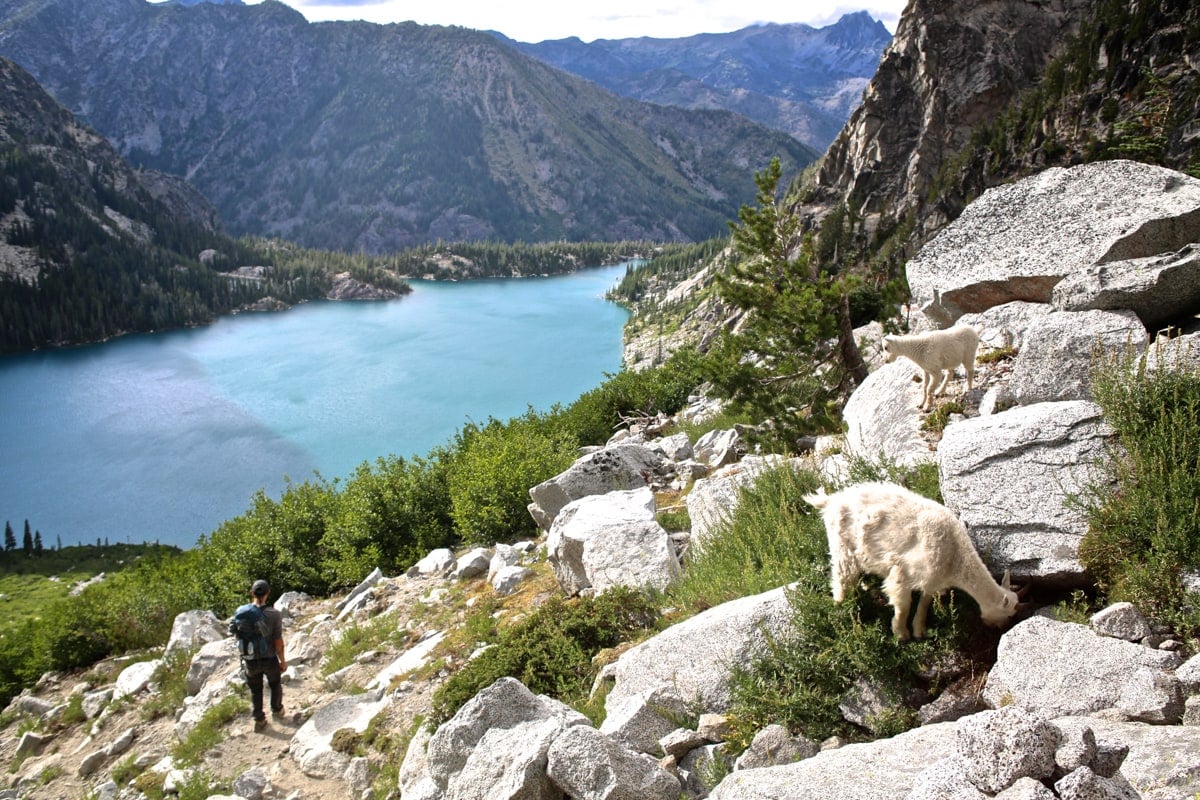
7) Be Considerate of Other Visitors
You should know this one from your mom or kindergarten – it’s the Golden Rule! Think about how your actions affect those around you and be considerate. Most people go out in nature to find peace so keep that in mind and be respectful.
Here are some tips to keep in mind:
- Keep excessive noise to a minimum.
- Everyone loves music but not everyone loves your music. Sound travels far, so if you must play music, ensure that the volume of your tunes is kept to a minimum so your neighbors can’t hear it.
- If you like to use earbuds to listen to music, keep the volume at a level where you can hear what’s going on around you in case
- People tend to get outside to get away from people so the more we can be out of sight and out of sound of people makes it more enjoyable for everyone.
- If you’re looking for peace and quiet, head out early in the day before the crowds and avoid planning trips in the high season or on busy weekends.
- Know proper hiking etiquette, such as when to allow people to pass and who has the right of way.
- Keep your pets under your control at all times and pick up after them.

That does it. Easy peasy right?! These are simple things that we can all do to minimize our impact and help preserve the health of our wild places and the experiences that we share out there.
Remember that Leave No Trace is not black and white but about making the best possible decision to minimize our impact in the specific environment and circumstances that we are in. Not a set of do’s and dont’s, but a set of guidelines to help us leave the places we visit as good or even better than we found them.
See you out there!
Do you have any questions or comments about the basic guidelines of Leave No Trace? Let us know in the comments below!
©1999 Leave No Trace Center for Outdoor Ethics: www.LNT.org

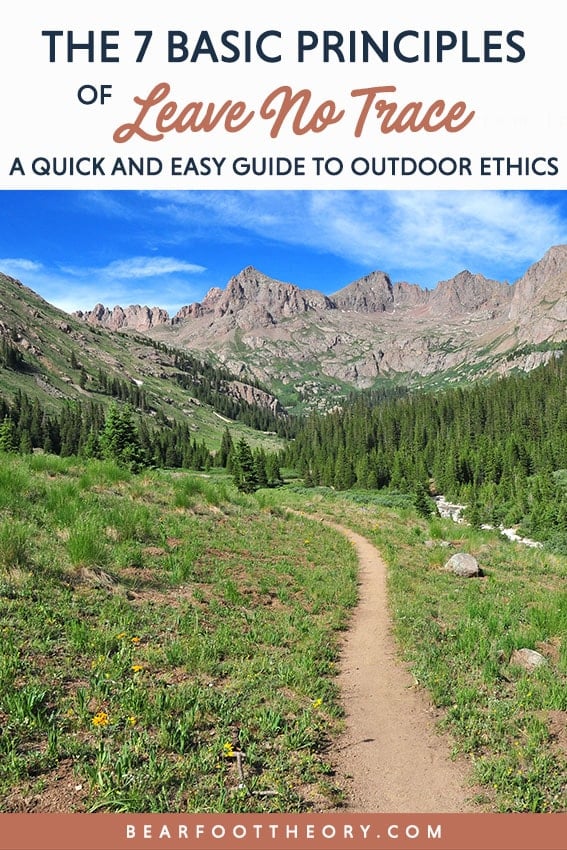
Glad you finally got to this information 🙂 Just off of, as you know, my 13th Grand Canyon rafting trip. I am constantly amazed on how well taken care of the canyon is, considering that close to 25,000 people per year use that corridor. I step into camps that I know were used the previous night, but find nothing to indicate that.
One mention I would like to make is regarding catholes in desert landscapes. Those areas have no or very few biologics in the soil, as mountain areas do, making the breakdown time for feces much longer. Therefore, the practice mentioned in your blog should be amended for those areas. As in – take it out 🙂
Another mention is to the awareness of crytogamic soils – prevalent in desert areas. These small, somewhat innocuous patches of black lichen-like growth takes hundreds of years to accumulate, and they are what holds the desert together. They should not be stepped on.
All in all a pretty good intro to wilderness ethics and stewardship – Scott
Thanks for chiming in Scott! Glad you liked the post! I updated it to mention that many areas have special regulations that require that solid human waste also be carried out. Hope you had an incredible trip through the Grand!
Awesome article, guys!
Thanks Jason! Goes hand in hand with your beginner hiking tips post.
Thought I’d put my question to the LNT crew, and got a response this morning. Agreeing with me that there are far fewer biologics in the desert soil, they suggested a shallower hole – 4 – 6 inches, compared to 6 – 8. They also suggested keeping in mind that water/rain in the desert often has a longer “carry”/being that much of the water runs off the surface. In short, be especially aware of proximity to water sources when considering a desert cathole.
And yes . . . the Grand Canyon lived up to it’s first name 🙂 Posted a number of my GoPro clips on FB . . . if you’re ever interested in getting ‘virtually’ wet 🙂
Glad you survived The Burn 🙂
Super cool article! And you are right about the dog thing, it’s so annoying when I see dogs out chasing squirrels and what not. I have made sure my dog is trained well enough to not leave the campsite.
Thanks so much Jay! Glad you enjoyed the post.
thank you for sharing this! Everyone should learn how to dispose properly for the love of our enviroment. Great post! All the love from Philippines.
https://campinggears.ph/outdoor-excursions-the-five-best-campsites-near-manila/
This is a great post! I always like to read up on how we can keep these trails in the best condition possible!
Hi Jessica, thanks for reading & for the kind note 🙂